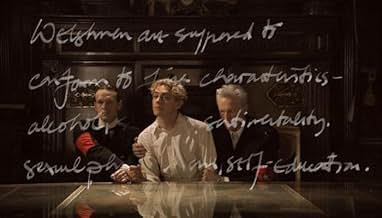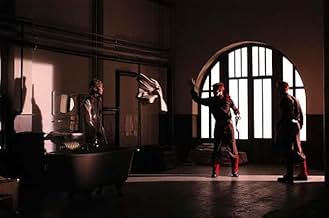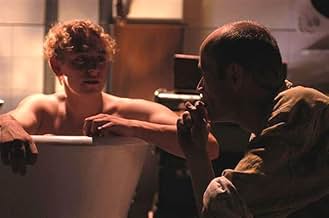The Tulse Luper Suitcases, Part 1: The Moab Story
- 2003
- 2h 7min
Ajouter une intrigue dans votre langueThe first of three parts, we follow Tulse Luper in three distinct episodes: as a child during the first World War, as an explorer in Mormon Utah, and as a writer in Belgium during the rise o... Tout lireThe first of three parts, we follow Tulse Luper in three distinct episodes: as a child during the first World War, as an explorer in Mormon Utah, and as a writer in Belgium during the rise of fascism. Packed with stylistic flourishes, it's a dense, comic study of 20th century his... Tout lireThe first of three parts, we follow Tulse Luper in three distinct episodes: as a child during the first World War, as an explorer in Mormon Utah, and as a writer in Belgium during the rise of fascism. Packed with stylistic flourishes, it's a dense, comic study of 20th century history, revolving around the contents of one man's suitcases.
- Réalisation
- Scénario
- Casting principal
- Récompenses
- 1 victoire et 1 nomination au total
- Jan Palmerion
- (as Jordi Molla)
- Pip
- (as Nilo Mur)
Avis à la une
This is the first film that I have watched at a film festival in about ten years that I can honestly say the vast majority of the audience left the theatre in a state of bemused disgust. It was one of the least enjoyable film experiences I have ever had, right up there with Salo, and UFO: The Movie. Maybe if viewed in sequence with the other parts of the production it might have some worth, but i doubt it. At best it may serve as an educational tool to the many film schools out there...
I won't attempt to describe much of the plot of Greenaway's mad project, such as I saw it, other than to say it traces the life of the title character through the two world wars of the twentieth century. If it is ever completed, one would expect there to be ninety-two "suitcases", hyperlinks as it were, to elements of Tulse Luper's life; one would expect there to be ninety-two common archetypical objects representing human existence; and one would expect there to be ninety-two characters in the movie, many of whom are introduced in split screen "auditions", which Greenaway imagined are analogous to parallel worlds. However, other than the number of times Tulse is physically assaulted, I can't recall any of the numbers going beyond thirty, so clearly there is a long way to go before the film can ever be called completed.
Greenaway described his visual metaphor as capturing elements of toolkits from multimedia computer graphics. The influence of a high bandwidth internet experience is also present. There was something analogous to a magnifier icon for creating a box around an element of a scene to be highlighted. There were panels of foreground videos playing over a background video reminiscent of a Windows Media Player or a Real Player. And there was one scene that split and adjusted the frame of the movie horizontally, like something I'd seen editing a Word document. Of course, all of these elements are subtly redefined to be nonobvious, and graphically balanced and symmetric. In one of the most visually impressive sequences in the film, the camera moves slowly from left to right, and then back, over a row of typists, each of whom has a bare light bulb above her head, and between each of them there is a semi-transparent display of rapidly changing document pages as might be scanned from a database.
Thematically, the film captures the best elements of Greenway. He said he expected Tulse Luper to be his magna opus, and the way he described the infinitely recursive structure of the story, it is likely to be an unfinished symphony. The numbers from Drowning by Numbers are here. The brutality of The Cook the Thief His Wife & Her Lover is, too. The film is expressly referential to Greenaway's earlier works, and he suggests that Tulse Luper is his alter ego.
Greenaway makes much of the architectural elements of the frame -- the Cartesian grid, lots of horizontal and vertical lines, vanishing perspectives, conic shadows of divergent illumination from a point source -- but for me what makes Greenaway Greenaway is brutality for an underlying theme, and lots of artfully naked, sexually expressive people. The visual elements could certainly exist without the rawness, but his films would not be as powerful without it. One scene clearly showed the results of a castration, and many others involved some sort of sexual domination. Greenaway said he is an atheist; I wondered, is he also a practitioner of sexual dominance in his personal life, or is he just doing this to be interesting? Between films, Greenaway sounded almost apologetic in explaining it was about totalitarianism and anti-semitism, but it's problematic for a Britisher in our age of anti-Americanism to present so many fascist characters uttering slurs against the Jews. It's sort of like Shakespeare's Merchant of Venice talking about the Holocaust. Does repeating blood libels, like the Jews supposedly being responsible for communism, somehow perpetuate the injury? Early in the film, a character repeats a mantra to "destroy the evil" as a way presumably to end war, but then later another suggests this sounds like too much of a violent thing to do; one wonders, which is it?
This was certainly the most powerful movie experience I had in 2003, although admittedly I didn't see very many good movies this year. And the scale of Tulse Luper is such that I'm sure it will be one of Greenaway's very best, even if it never achieves a state of completion. It helps vastly of course to see it in the theater and in high definition. While Greenaway regretted the French subtitles, as the version we saw was shown at Cannes, I actually found they added another dimension to the film: not only did they help me catch what the characters were saying when they spoke too fast to hear, but the nuances of French vis-a-via English were enlightening.
His fundamental notions of the world are built on overlapping conceptual frameworks, ordered frameworks. In this, he follows the Joycean tradition of "Finnegans Wake," which layered all sorts of frameworks from Kabbalistic, Vican, mythological, even geographic sources. It was all merged according to a dream logic since we had no other template in that day and used every lexical and literary device he could muster.
Where Joyce had to make do with dream-layering, our Peter gets to use already familiar web- referenced multimedia overlays. He surely knows how to use the software to extend the art of editing into new dimensions. Wow, just on that score.
And where Joyce used obtuse frameworks with the intent of his book being a life's reading, Greenaway uses obvious overlapping frameworks: numbers, his own life and the mythology from his prior films. Some categories, like the periodic table. Oddly, he hasn't been as thorough in this film as he has in some others: Vermeer's theories of light, animals, sexual stereotypes, the written word, various frameworks of introspection and reflection. Different slices on gender.
Anyway, the point is that where Joyce was esoteric, Greenaway strives to be obvious, though manylayered, even juvenile, in his frameworks. He wants these to be so simple and grand that he can stretch them to many web sites, films, CDs, games, and (I presume) books and installations. Someone can casually enter a part of the larger work and intuit the order of the thing.
Each fan of Greenaway will have to make her own decisions on what she likes in terms of the different balances he has struck. As for me, I want a tighter integration of framework and image than he has here. This is why I value his "book" films the highest.
What does this add to what we have? Sadly, not much, except an attempt to integrate himself and some of the political sweeps of the ordinary world, which he tags to nuclear control. I've often thought that the artists themselves are dumber than the art they produce and the greater distance we have from their personalities, the better.
If you have talked to Greenaway, you'll see this in a flash. He has some good headlines, having to do with the bankruptcy of narrative in film. But beyond that, his films (some of them) soar, while his own spoken narrative crawls.
Ted's Evaluation -- 3 of 3: Worth watching.
Le saviez-vous
- Anecdotes'Cissie Colpitts' is the name shared by the three main female characters in Triple Assassinat dans le Suffolk (1988), by the same director.
- ConnexionsEdited into The Tulse Luper Suitcases: Antwerp (2003)
Meilleurs choix
- How long is The Tulse Luper Suitcases, Part 1: The Moab Story?Alimenté par Alexa
Détails
- Date de sortie
- Pays d’origine
- Site officiel
- Langues
- Aussi connu sous le nom de
- Les maletes de Tulse Luper: La història de Moab
- Lieux de tournage
- Sociétés de production
- Voir plus de crédits d'entreprise sur IMDbPro
Box-office
- Budget
- 10 000 000 $US (estimé)
- Montant brut mondial
- 90 071 $US
- Durée
- 2h 7min(127 min)
- Couleur
- Mixage
- Rapport de forme
- 1.85 : 1









































